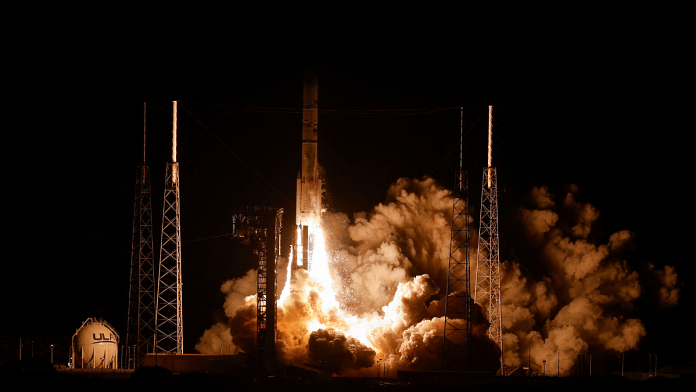Bengaluru: The journey of a lunar lander commissioned by NASA and built and operated by private US space company, Astrobotic Technology, to the moon has gotten off to a wobbly start. Astrobotic launched its Peregrine Mission One moon lander on 8 January, but the spacecraft began to malfunction as soon as it was released from the rocket.
The lander, which took off from Florida’s Cape Canaveral atop United Launch Alliance’s Vulcan Centaur rocket Monday morning and separated 50 minutes after the launch, was expected to touchdown on 23 February but is currently experiencing propulsion issues and fuel leak in space.
After it separated from the rocket, the lander moved in the direction of the moon through trans-lunar injection, but could not orient itself successfully to face the sun so that it could charge its solar panels. While investigations into what went wrong are ongoing, the company suspects that the problem was caused due to an anomaly in its propulsion systems.
As of 9 January, the spacecraft measuring about 1.9 m tall and 2.5 m wide and carrying 265 kg of payloads or instruments was floating between the earth and the moon.
This moon lander — the first one built in the US since the Apollo programme — is reportedly carrying, among scientific instruments and other things, the remains of several cast members of the American science fiction series Star Trek, the DNA of former US president John F. Kennedy, and a piece of Mount Everest.
In a post on X, Astrobotic posted a picture of the spacecraft stating: “The camera utilized is mounted atop a payload deck and shows Multi-Layer Insulation (MLI) in the foreground. The disturbance of the MLI is the first visual clue that aligns with our telemetry data pointing to a propulsion system anomaly”.
Update #5 for Peregrine Mission One: pic.twitter.com/94wy2J0GyA
— Astrobotic (@astrobotic) January 8, 2024
The company continues to post updates of the investigation on social media as it makes its findings.
Also Read: Aditya L-1 success won’t stop project director Nigar Shaji. Next mission Chandrayaan-4 & Venus
Scientific payloads, human remains — what Peregrine Mission One is carrying
According to NASA’s website, Peregrine Mission One was selected as a part of NASA’s Commercial Lunar Payload Services, which will provide transportation on contract to the lunar South Pole region.
There are two more planned missions, called Mission Two and Mission Three, which will also carry payloads that include human remains on behalf of space burial companies like Elysium Space and Celestis.
The Peregrine lander is expected to function only for 14 days or one lunar day as it runs on solar power.
According to Astrobotic’s website, among the payloads being carried in the lander are five small robots from Mexico — the first Latin American scientific instrument to be placed on the moon — and Carnegie Mellon University’s (USA) 2 kg rover student project.
In addition, NASA provided a retroreflector for laser studies and a radiation monitor for the lunar surface. The German Aerospace Center — the country’s national center for aerospace, energy, and transportation research — has also sent a radiation monitor that will work in conjunction with the NASA instrument.
NASA also had a descent and landing sensor, a spectrometer to measure water and carbon dioxide, another spectrometer to determine soil composition, and a third spectrometer to study the lunar exosphere and volatiles in it on the mission.
Besides these, the Astrobotic lander carried a navigation sensor for the lunar surface. Multiple countries and private players also sent time capsules with art, books, music, cryptocurrency, and human remains.
Status and next mission
The landing on the moon was planned for 23 February after a 46-day cruise towards the Moon. However, about seven hours after launch, the company released a statement noting an anomaly that prevented the spacecraft from facing the sun. The development prompted Astrobotic to perform an unplanned manoeuvre to reorient the spacecraft, which was successful after a brief communications blackout.
The company stated that the propulsion problem has been linked to a leak that is depleting the spacecraft’s fuel gradually, preventing it from reaching the Moon.
“At this time, the goal is to get Peregrine as close to lunar distance as we can before it loses the ability to maintain its sun-pointing position and subsequently loses power,” the company stated on social media.
Update #6 for Peregrine Mission One: pic.twitter.com/lXh9kcubXs
— Astrobotic (@astrobotic) January 9, 2024
The spacecraft is currently cruising towards the moon while facing the sun but its fuel is expected to run out in another 30-40 hours, after which communication with it will be lost.
(Edited by Uttara Ramaswamy)
Also Read: ‘India don dey Moon now’: How world media reported Chandrayaan-3, from Pidgin to Queen’s English



